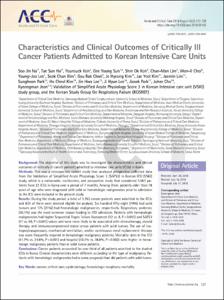KUMEL Repository
1. Journal Papers (연구논문)
1. School of Medicine (의과대학)
Dept. of Internal Medicine (내과학)
Characteristics and Clinical Outcomes of Critically Ill Cancer Patients Admitted to Korean Intensive Care Units
- Keimyung Author(s)
- Choi, Won Il
- Department
- Dept. of Internal Medicine (내과학)
- Journal Title
- Acute and Critical Care
- Issued Date
- 2018
- Volume
- 33
- Issue
- 3
- Keyword
- cancer; critical care; epidemiology; hematologic neoplasm; mortality
- Abstract
- Background:
The objective of this study was to investigate the characteristics and clinical outcomes of critically ill cancer patients admitted to intensive care units (ICUs) in Korea.
Methods:
This was a retrospective cohort study that analyzed prospective collected data from the Validation of Simplified Acute Physiology Score 3 (SAPS3) in Korean ICU (VSKI) study, which is a nationwide, multicenter, and prospective study that considered 5,063 patients from 22 ICUs in Korea over a period of 7 months. Among them, patients older than 18 years of age who were diagnosed with solid or hematologic malignancies prior to admission to the ICU were included in the present study.
Results:
During the study period, a total of 1,762 cancer patients were admitted to the ICUs and 833 of them were deemed eligible for analysis. Six hundred fifty-eight (79%) had solid tumors and 175 (21%) had hematologic malignancies, respectively. Respiratory problems (30.1%) was the most common reason leading to ICU admission. Patients with hematologic malignancies had higher Sequential Organ Failure Assessment (12 vs. 8, P<0.001) and SAPS3 (71 vs. 69, P<0.001) values and were more likely to be associated with chemotherapy, steroid therapy, and immunocompromised status versus patients with solid tumors. The use of inotropes/vasopressors, mechanical ventilation, and/or continuous renal replacement therapy was more frequently required in hematologic malignancy patients. Mortality rates in the ICU(41.7% vs. 24.6%, P<0.001) and hospital (53.1% vs. 38.6%, P=0.002) were higher in hematologic malignancy patients than in solid tumor patients.
Conclusions:
Cancer patients accounted for one-third of all patients admitted to the studied ICUs in Korea. Clinical characteristics were different according to the type of malignancy. Patients with hematologic malignancies had a worse prognosis than did patients with solid tumor.
- Keimyung Author(s)(Kor)
- 최원일
- Publisher
- School of Medicine (의과대학)
- Citation
- Jisook Park et al. (2018). Characteristics and Clinical Outcomes of Critically Ill Cancer Patients Admitted to Korean Intensive Care Units. Acute and Critical Care, 33(3), 121–129. doi: 10.4266/acc.2018.00143
- Type
- Article
- ISSN
- 2586-6060
- Source
- https://www.accjournal.org/journal/view.php?doi=10.4266/acc.2018.00143
- Appears in Collections:
- 1. School of Medicine (의과대학) > Dept. of Internal Medicine (내과학)
- 파일 목록
-
-
Download
 oak-2018-1752.pdf
기타 데이터 / 2.13 MB / Adobe PDF
oak-2018-1752.pdf
기타 데이터 / 2.13 MB / Adobe PDF
-
Items in Repository are protected by copyright, with all rights reserved, unless otherwise indicated.